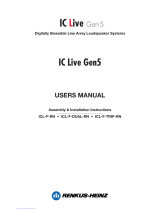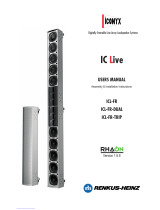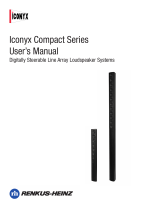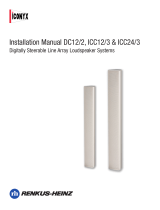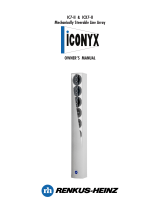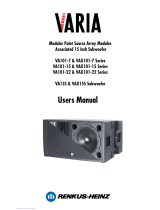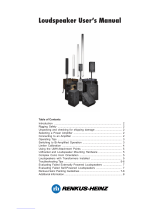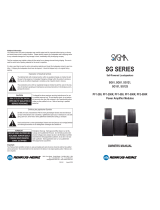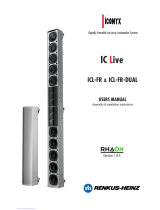Page is loading ...

Page 1 of 3
Application Note IC-3
March, 2023
The DC and Iconyx series of steerable column arrays are
very low-prole and can be installed in many applications
where conventional loudspeakers would be visually un-
acceptable, however, there are still some venues where
even the very slender Iconyx arrays need to be hidden.
Renkus-Heinz Application Engineering has developed this
Application Note as a guideline for mounting Iconyx arrays
in a recess or niche in a wall.
General Recommendations
When mounting any loudspeaker in a recess or niche the
front bafe or grille of the loudspeaker should be ush with
the wall in which you are mounting the loudspeaker. Having
the loudspeaker protrude a bit from the wall is also okay,
acoustically, but may not be acceptable, visually.
Avoid having the loudspeaker behind the surface of the wall
any more than 1/4 in. (6 mm), as the edges of the recess
will have a very negative effect on the sound quality of the
loudspeaker, and if it’s deep enough, the recess will also
affect the dispersion.
The interior of the recess should be treated with acoustically
absorptive material. Any sound that is in the recess will be
highly colored, and you want as little of it as possible to
radiate back out into the room. You must not completely
stuff the recess with berglass, as this will result in the am-
plier overheating. See the drawings for our recommended
treatment amount and location. Renkus-Heinz recommends
berglass duct liner for this application. It’s available in
semi-rigid sheets, it’s relatively inexpensive and it’s black.
To make sure that the loudspeaker is invisible behind the
grille or fabric, use a black loudspeaker and paint the interi-
or of the recess or niche black as well.
Metal Grille Material
To conceal the loudspeakers, a perforated metal grille or
fabric or a combination of both can be used. For metal
grilles use perforated sheet metal with an open area in the
range of 45% to 55%. Sheet’s with open areas of less than
45% will result in acoustic losses and potential cooling
issues as they restrict airow. Sheet’s with open areas of
more than 55% are not common and may make attach-
ing the grille fabric difcult. Most acoustic fabrics can be
attached to a grille with spray adhesive like 3M Super 77.
Grille Fabric
Grille fabric or cloth, whether attached to a metal grille or
stretched on a frame, should be acoustically transparent
fabric specically designed for loudspeaker use. This is
available from companies such as Acoustone and Mellotone.
The fabric that is commonly used on absorptive panels
is often rather absorptive at high frequencies and isn’t
recommended. The fabric must be open enough to allow
cooling airow. If you can’t easily breathe through it; it’s not
open enough. Finally, check with the local Authority Having
Jurisdiction, AHJ. This could be the re marshal or building
inspector. Ask if the fabric
needs to be ame retardant.
It’s safest to assume that it
will be required and obtain
fabric that has been treated.
Amplier Cooling
The DC and Iconyx series are
self-powered loudspeakers,
so cooling for the internal
ampliers must be ad-
dressed. The ampliers used
in the Iconyx are all Class D;
Class D ampliers run very
efciently and thus relatively
coolly, but you must provide
for cooling airow. The loud-
speaker’s mounting brackets
Abstract: Flush mounting any loudspeaker requires special design consideration, and self-powered loudspeak-
ers require extra planning for adequate cooling. This application note discusses those design considerations and
makes recommendations for ush mounting the DC and Iconyx series of steerable line arrays.
Flush or Recess Mounting Steerable Arrays
Warm air out
Cool air in
Warm air out
Cool air in

Page 2 of 3
will space the loudspeaker far enough off the mounting sur-
face to allow airow; you must allow enough space around
the loudspeaker for the cooling air to circulate. In addition
you must allow the hot air to exit the recess and cool air to
enter. Do this by extending the opening for the loudspeaker
several inches or centimeters above and below the array.
Please see the drawings for minimum recommended sizes
of these vent openings.
These guidelines assume the loudspeaker and its recess are
exposed to temperatures not exceeding normal indoor tem-
peratures. Indoor installations should avoid sources of heat
such as heating ducts and radiators, lighting xtures, etc.
If the loudspeaker is installed outdoors, more airow around
the loudspeaker—substantially more if the installation will
be exposed to full sunlight—is required.
The cooling provided by the ventilation suggested should be
sufcient for any normal operation of the loudspeakers. If,
however, the loudspeakers are continuously run very close
to or even into their protection limiting, the power ampliers
may eventually “thermal off.” If this happens, you’ll need to
install fans or some other method of positive cooling or re-
duce the level of the loudspeakers. In all cases, the ambient
temperature around the loudspeaker must be kept to 140° F
(60° C) or below.
DC & ICC Recess Minimum Dimensions
DC12/2 ICC12/3 ICC24/3 ICC36/3 ICC48/3
Inches MM Inches MM Inches MM Inches MM Inches MM
Height “H” 36-9/16 929 45-1/2 1156 87 2210 128-1/8 3254 169 4293
Depth “D” 5-9/16 141 6-1/2 165 6-1/2 165 6-1/2 165 6-1/2 165
Width “W” 6 152 6-1/2 165 6-1/2 165 6-1/2 165 6-1/2 165
Vent “V” 3 76 3 76 4 102 5 127 6 152
H
D = 5-9/16"
W = 6"
152 mm
D = 141 mm
165 mm
W = 6-1/2"
D = 6-1/2" D = 165 mm
H
V V
V
V
1 in./25 mm
Fiberglass duct
liner. 3 in./75 mm
deep.
1 in./25 mm
Fiberglass duct
liner. 3 in./75 mm
deep.
76 mm 76 mm3"3"
D = 7-11/32"
W = 8-1/4"
210 mm
D = 186 mm D = 8-1/8" D = 206 mm
W = 10"
254 mm
76 mm3"
H
V
V
1 in./25 mm
Fiberglass duct
liner. 3 in./75 mm
deep.
V
V
H
76 mm 3"
1 in./25 mm
Fiberglass duct
liner. 3 in./75 mm
deep.

Page 3 of 3
H
D = 5-9/16"
W = 6"
152 mm
D = 141 mm
165 mm
W = 6-1/2"
D = 6-1/2" D = 165 mm
H
V V
V
V
1 in./25 mm
Fiberglass duct
liner. 3 in./75 mm
deep.
1 in./25 mm
Fiberglass duct
liner. 3 in./75 mm
deep.
76 mm 76 mm3"3"
D = 7-11/32"
W = 8-1/4"
210 mm
D = 186 mm D = 8-1/8" D = 206 mm
W = 10"
254 mm
76 mm3"
H
V
V
1 in./25 mm
Fiberglass duct
liner. 3 in./75 mm
deep.
V
V
H
76 mm 3"
1 in./25 mm
Fiberglass duct
liner. 3 in./75 mm
deep.
IC-R Recess Minimum Dimensions
IC8-RN & RD
IC16-RN & RD
IC16-8-RN & RD
IC24-RN & RD
IC24-16-RN & RD
IC32-RN & RD
IC32-24-RN & RD
Inches MM Inches MM Inches MM Inches MM
Height “H” 43-11/16 1110 82-3/4 2102 121-13/16 3094 160-7/8 4086
Depth “D” 7-11/32 186 7-11/32 186 7-11/32 186 7-11/32 186
Width “W” 8-1/4 210 8-1/4 210 8-1/4 210 8-1/4 210
Vent “V” 3 76 4 102 5 127 6 152
ICL-F Recess Minimum Dimensions
ICL-F-RN & RD ICLF-DUAL-RN & RD ICLF-TRIP-RN & RD
Inches MM Inches MM Inches MM
Height “H” 56 1422 105 2667 154 3912
Depth “D” 8-1/4 206 8-1/4 206 8-1/4 206
Width “W” 10 254 10 254 10 254
Vent “V” 4 102 5 127 6 152
/
